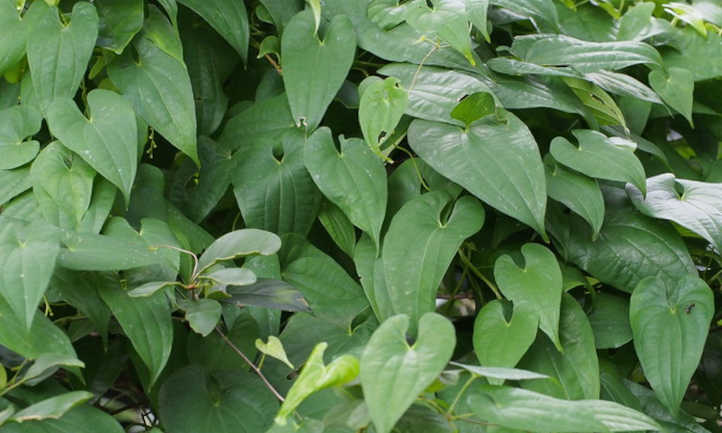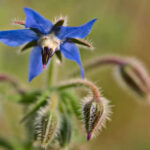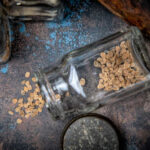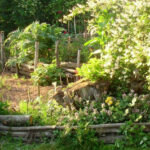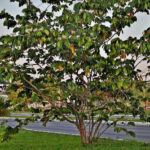One interesting wild yam species is Dioscorea japonica, also known as Yamaimo. It’s a Japanese wild yam with high value in Japanese cuisine. Similar to the Chinese yam, it’s known as the Japanese cinnamon vine, distinguishing it from the Chinese cinnamon vine. Their common names are often used interchangeably.
It stands out among other yam species because it’s one of the few that’s eaten raw. It’s also cold-hardy, differentiating it from Chinese yam, or cinnamon vine. They are both members of the true yam Dioscoreaceae family, in the genus Dioscorea and they both grow into multiple feet-long tubers.
Yamaimo is native to the mountains of Japan but takes off in North America. Most of the problems people have with this glutinous yam is controlling it. Its Chinese relative is an invasive species in certain parts of the United States, and also requires maintenance. But you can grow yamaimo at home.
Quick Care Guide
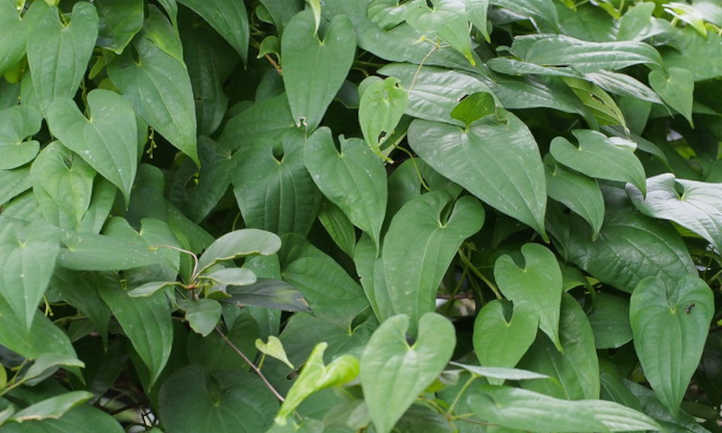
| Common Name(s) | Yamaimo, mountain yam, Japanese yam, East Asian mountain yam, Jinenjo, shan yao, nagaimo, cinnamon vine |
| Scientific Name | Dioscorea japonica |
| Days to Harvest | 730 days |
| Light | Full sun to partial shade |
| Water | 1 inch per week |
| Soil | Light, rich, well-draining |
| Fertilizer | Slow release, pellet applied after 8 weeks of growth |
| Pests | Root knot nematodes, birds, mice |
| Diseases | Root rot |
All About Dioscorea Japonica
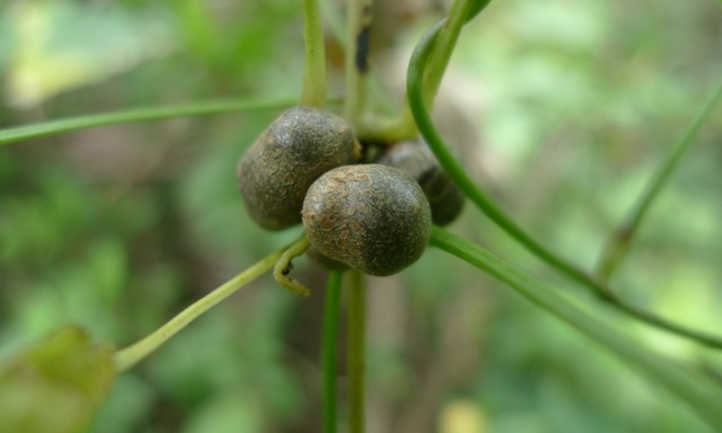
Yamaimo (Dioscorea japonica) is a Japanese yam native to Japan, Korea, China, Taiwan, and Assam. It’s commonly referred to as mountain yam, Japanese yam, East Asian mountain yam, Jinenjo, shan yao, nagaimo, and Japanese cinnamon vine. In Korean it is known as cham ma 참마 and dang ma 당마. It grows wild in the mountains of its native Japan, where there is a tradition of growing both the Japanese yam and the Chinese cinnamon vine. There, Dioscorea japonica is called Yamaimo – literally Japanese yam.
The most striking part of Yamaimo is its long white tuber. Usually buried 1 to 3 feet underground, they reach 1 to 3 feet long. They are speckled with a tan to whitish skin. A single perennial climbing vine grows from each wild yam that reaches 10 feet tall. The vine’s leaves are elongated and look like other heart-shaped sweet potato leaves.
Yamaimo is dioecious and requires cross-pollination for the reproduction of seeds. Female plants produce small string-like white or yellow flower bunches in late summer that resemble oak pollen and smell like cinnamon. Male plants grow small tubers above ground on the leaf axils of the vine, known as air potatoes. Most found in North America are male Dioscorea japonica plants.
Yamaimo edible parts include the tuber, and air potatoes (or seed), but the tuber requires some processing before they can be consumed. The air potatoes can be roasted and snacked on like edamame. The air tuber and tuberous root have a neutral flavor that often acts as a binder for various foods – like soba noodles, for instance.
The food chem of the yam is most interesting. When eaten raw, they’re either shredded or grated to remove the fibrous, indigestible parts. Those who handle the raw tubers wear gloves because they irritate the skin. They’re mixed with other flavorings, and taste a bit like a potato. But their texture is varied depending on the preparation.
They’re used in sweet confections for binding, and sometimes they’re cooked into a soft, sticky, and crunchy pancake. They’re commonly made into dumplings thrown into miso soup, and the slippery texture or slimy texture of grated Yamaimo is excellent in noodle dishes of all kinds.
Yamaimo is medicinal in China and it’s considered wild mountain medicine in Japan where it is used to treat digestive disorders, and to support kidney functioning. Like other wild yam species, it regulates hormones and is sometimes used as birth control. In phyto-chemistry Dioscorea japonica is considered antioxidant and anti-inflammatory. In the Edo Period in Japan sliced yamaimo was added to baths to promote virility.
Current studies spearheaded by Sei-Ichi Nakamura indicate dang ma 당마 (or cham ma 참마) has antimutagenic capabilities via alcohol compounds contained in the plant’s chemistry. Dioscorea japonica to Sei-Ichi Nakamura and associates shows promise in the suppression of cancer.
There are 4 accepted formal botanical varieties of Yamaimo (Dioscorea japonica) – which translates in English to Japanese yam. Several formal botanical varieties are almost identical. They are as follows:
- In Japan, Korea, Ryukyu, Bonin, Anhui, Fujian, Guangdong, Guangxi, Guizhou, Hubei, Hunan, Jiangsu, Jiangxi, Sichuan, Zhejiang, and Taiwan: Dioscorea japonica var. japonica
- In Assam: Dioscorea japonica var. nagarum
- In Guangdong, Guangxi, and Taiwan: Dioscorea japonica var. oldhamii
- In Anhui, Fujian, Guangxi, Guizhou, Hubei, Hunan, Jiangsu, Jiangxi, and Zhejiang: Dioscorea japonica var. pilifera
Planting Yamaimo
Plant each tuber in late spring. Prepare a sight with light, rich, well-draining media, and plant it at least 1 foot deep. 3 feet is best. Because the wild yam of Yamaimo is fragile and can break during the harvest growers plant it in a plastic tube in a raised bed, or a barrel of some kind. The area you plant it in should receive full sun or partial shade. Once you’ve selected and prepared the planting site, plant the tuber, and within a month or so you’ll have new shoots in the form of seedlings. Sprouted Yamaimo air potatoes can be planted in the same manner. If spring is already past, consider planting rooted stem cuttings in summer. We’ll discuss more of the ins and outs of propagating Japanese yam later in this piece.
When you plant your Dioscorea japonica, provide a sturdy trellis to support its upward growth. This could be along a chain-link fence, or via a wooden trellis you’ve constructed. At first, a single pole will suffice, but as the vine grows provide more support. Consider this selecting your planting site.
Care
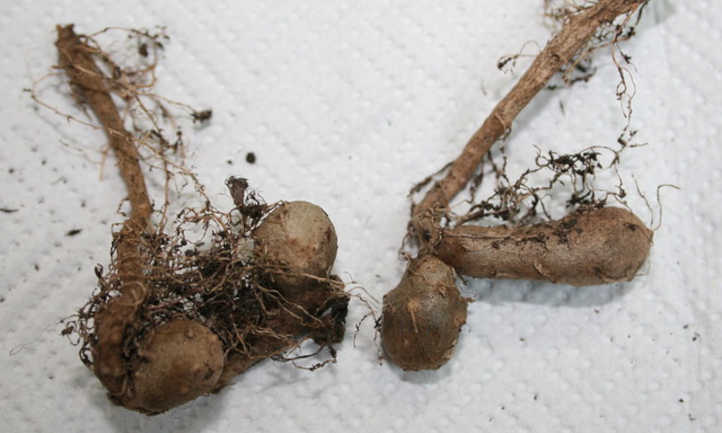
Once you have an established Dioscorea japonica vine, you’re on your way to harvesting a Japanese mountain yam. Because the tuber of Yamaimo takes a while to grow, you’ll have time to focus on caring for the vine.
Sun and Temperature
Dioscorea japonica needs full sun to partial shade. Give it at least 6 hours of sunlight per day. This cold-hardy Japanese yam can withstand cold down to -25 degrees Fahrenheit and heat up to 100 degrees. In the winter, Dioscorea japonica will die back, but the tuber will continue to grow safe in the warm earth. If you have particularly cold winters, burying the yam deeper will help protect it from the frozen ground.
Water and Humidity
The Japanese yam Dioscorea japonica needs consistently moist soil to thrive. Water the plant daily in the morning, ensuring the top two inches are moist, but not waterlogged. At least 1 inch of water per week is best. In the heat of summer, water a bit more to support adequate tuber growth. Yamaimo doesn’t need added water in areas and seasons when it rains often. Soaker hoses and drip irrigation are the best modes of watering the East Asian mountain yam, but a consistent and slow trickle from a hose or watering can work just as well, as long as the medium is well-draining and doesn’t get too wet. Yamaimo is not drought tolerant.
Soil
Light, rich soil is best for Dioscorea japonica. If your media base is heavy clay soil, cultivate this wild mountain medicine in a large container. If you’d like to grow it in the ground, plant Yamaimo deeply, up to three feet. A light loamy soil that is neutral to mildly alkaline is best. Good drainage is essential because a lack creates conditions where diseases can proliferate. The pH range for growing Dioscorea japonica is 6.1 to 7.8. Use small amounts of garden lime if your soil is too acidic. This glutinous yam needs moist soil, so provide some coco coir or sphagnum peat moss if your soil has a hard time holding moisture.
Fertilizing
Fertilize your Zhejiang Dioscorea japonica var. japonica or your Dioscorea japonica var. of another kind after 4 weeks of growth, in early summer. Use slow-release pellet fertilizers that are full-spectrum, at 10-10-10 or 20-20-20. If you do fertilize later in the season, use a 10-20-20 fertilizer which contains the phosphorous and potassium content to help you produce large tubers.
Pruning
Prune your Dioscorea japonica var. to control its spread. Trim parts to train the vine’s shape as well. Because the small air potatoes produced on male vines and their clones can drop to the ground and propagate, take time to remove those so they don’t take over.
Another appropriate time to prune is at the end of the growing season in the fall. Remove all the leaves when they’ve browned, and leave a small 5-inch stem at the base. Mulch to protect it from the cold.
Propagation
Propagate any Dioscorea japonica var. from cuttings in early to late summer, depending on where you live. Those in temperate zones should plant cuttings in early summer, after rooting them in water in spring. It will take at least two years for a substantial tuber to form, which may need to be excavated and transplanted more deeply after a few months of growth.
Yamaimo is propagated is by the division of a full-grown tuber, or by seed, which comes from the edible air potato. The latter of these is the most common form of propagation in Japan. When you harvest the bulbs, lay them in a box in the shade in a warm, dark place. They will sprout on their own this way. Then sort out each seed that is irregularly formed, and discard them. Take the rest of the edible bulbs and plant them a couple of inches in the ground, ensuring the seed sprout is not broken in the process. In about 5 weeks you’ll have seedlings you can transfer to your preferred area for growth.
To divide this edible native Japanese tuber, wait for the plants’ dormant season in winter. Carefully remove the tuber and cut it into appropriate parts with enough skin for adequate sprouts to form. Then plant the tuber parts deeply in late spring in mildly alkaline soils that are light and rich. Train them onto a trellis.
Harvesting and Storing
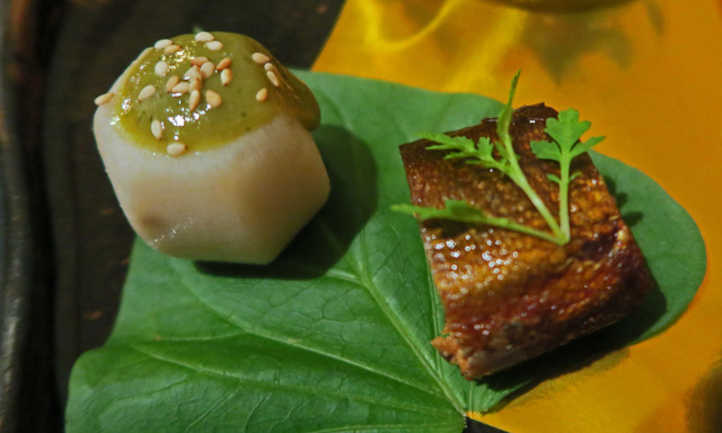
The best part of spending years growing yams in the Dioscorea genus is harvesting the tuber. It is delicate, so take some care in this process.
Harvesting
Like other members of the Dioscorea genus, harvest your Yamaimo in the fall after two years of growth from a seedling. If you’ve prepared a plastic tub or tall planter to grow this Japanese and Korean native, simply tip over the bin and slowly excavate the tuber, taking care not to break it in the process. Native Dioscorea japonica growers sometimes plant them in the dirt in plastic sleeves, making it easier to take them out of the earth without breaking them. Do not wash the Yamaimo tuber until you’re ready to use it.
Harvest the tiny air tuber from Yamaimo throughout its growth period. Sort these, saving the irregular ones for eating, and the more uniform ones for propagation.
Storing
The tuber keeps for 1 month stored in a cool dry place, unwashed and wrapped in newspaper. If you don’t have a cool dry place in your house, try the refrigerator for a couple of days. Cooked Yamaimo keeps in an airtight container in the fridge for 2 to 3 days. Powdered forms of the yam keep for 1 year in an airtight package or container at room temp. In grated form, the Yamaimo keeps in the freezer and used as needed within 2 weeks. Some sources slice the yam and dry it, storing it at room temperature in a mason jar, though it’s unclear how long it can be kept this way.
Troubleshooting

With Yamaimo, you won’t encounter many issues, other than ensuring it has a good growing medium and doesn’t get out of hand. Let’s talk about a couple of things you’ll want to look out for.
Growing Problems
Give Japanese yams light, rich, well-draining soil. If you plant your tuber in the earth in an area with heavy clay soil, you’ll stunt its growth and create conditions where disease can occur. As the air potatoes grow and drop to the ground, pick them up. Otherwise, you’ll be removing suckers the following spring.
Trellis your Yamaimo adequately so it has good support. This support provides room for your air potatoes to grow and gives your tuber more access to sun and water. When you’re harvesting the tuber, try not to break it. Provide it with a plastic tube, or sleeve, or plant it in a raised bed that can have a wall removed while you harvest. Broken yams will not last as long as intact ones.
Pests
Root-knot nematodes are the worst pest for this yam. These small white to yellow worms drill into tubers and lay eggs there. While they feed, they create nodules on each tuber, distorting the molecular and chemical composition of your harvest. Because it takes time to grow a tuber, prevent nematodes with a beneficial nematode species. Apply these diluted in water to the planting area when soil temperatures are between 42 and 95 degrees. Then follow up with a second application one to two weeks later. This ensures knot nematodes aren’t present when you plant your tuber.
Birds and mice will feed on your air potatoes if you’re not careful. While this shouldn’t be an issue at a certain point if you want to save them, try an owl decoy to keep birds away. However, mice and birds may assist you in keeping the vine under control.
Diseases
In poorly draining soils, root rot can be an issue. The problem with this disease is you won’t know it’s there until harvest. Yamaimo will take on large discolored splotches that cause parts of it to go bad before you can enjoy it. Late stages of the disease often show themselves in storage as the discoloration progresses to a moldy spot. Do not plant your tuber where you know root rot has existed. Provide a medium that is light, rich, and well-draining. If you’re unsure about the planting area, plant your tuber in a deep barrel of some kind. There is no cure for this disease. If your tuber gets infected, propagate an air potato and start again.
Frequently Asked Questions

Q: Is Chinese yam the same as Japanese yam?
A: Both the Japanese yam and Chinese plants produce a glutinous yam that is used interchangeably. They do share the same genus, but what differs between them is their species and their hardiness. Chinese yams grow in hotter climates, while the formal botanical varieties of Japanese yam have exhibited cold hardiness.
Q: How do you eat yamaimo?
A: In Japanese cuisine, it’s grated and made into a paste that can be formed into dumplings for soup. It’s also sliced, wrapped in bacon, battered, and deep-fried. It has sweet applications as well! Because there are several formal botanical varieties native in Taiwan, Japan, China, and Korean food chem, there are many applications for these plants. One familiar use for the plants is to improve the texture of noodles.

